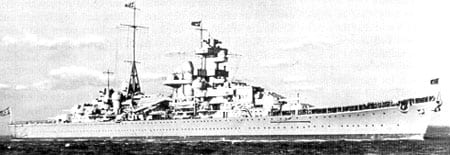Schwere Kreuzer Blücher
 History15 Aug 36: Laid down at Deutsche Werke, Kiel, as SchwereKreuzer G. 08 Jun 37: Launched. 20 Sep 39: Commissioned as the Schere Kreuzer Blücher.Completion was delayed by numerous modifications to the design includingan altered bow and reconstructed funnel. Mid Nov 39: Begins trials and the working up process around Kiel. Shespends much of the month in dock having minor problems corrected. 27 Nov 39: Leaves Kiel for Gotenhafen. For the next two weeks sheconducts trials with her machinery and guns in the Eastern Baltic.These reveal problems that require another dockyard spell so she returnsto Kiel 07 Jan 40: Leaves Kiel to work-up and train in the Eastern Baltic. Theseverity of the winter and the ice bound conditions that result hindersthis process. 17 Jan 40: Returns to Kiel. Trapped at her buoy by ice until 27 Janwhen she returns to dock for more work. After five months incommission, her crew has only benefited from 19 days training at sea. 06 Apr 40: Embarks 800 men of the 163rd Infantry Division, ammunitionand supplies. She has not conducted any main battery, damage-control,nor action station drills and is not considered fully operational.None-the-less, the requirements of the Norwegian invasion and theshortage of KMS heavy units compel her participation in operationWeserubung. 07 Apr 40: Departs Swinemunde as the lead ship in Group Five with Emdenand 3xTB. Joined by Lutzow. 08 Apr 40: Group Five is attacked by RN SS Trition. All Britishtorpedoes are avoided. 09 Apr 40: 0000 hours, approaches Oslofjord. Seven rounds are fired bythe Norwegian batteries at the mouth of the fjord, but no hits areobtained. The Germans do not return fire and their column is pass thebatteries by 0045. 09 Apr 40: 0440: Illumination by search lights while proceeding upfjord. 0521, the Oskarsborg battery (2x280mm and 1x305mm notoperational) opens fire at 1,700m. The first round strikes Blucher’sflak control platform. Her antiaircraft guns return fireineffectively. A second 280mm shell hits the aircraft hanger and startsa serious fire. Then the 150mm battery at Drobak opens up from 400-600meters to starboard and scores 20 hits from 25 rounds fired. Finally,two torpedoes from the Kaholmen Island battery strike the ship. 09 Apr 40: 0530. Blucher passes the batteries at 15 knots on emergencysteering. However, the torpedo hits are serious, eventually causingthe loss of all power and forcing her to anchor up the fjord. Moreover,the fire from the aircraft hanger begins to ignite army ammunitionstored about the ship, setting off an enormous fire midships andisolating the stern from the bow. The rest of the force does notattempt the passage, leaving Blucher alone. The explosion of the 105mmmagazine provides the final blow, creating a list of 45�. She capsizesand sinks at 0722. | |||||||||||||
Commanders | |||||||||||||
| Kpt.z.S. Heinrich Woldag 9.20.39 – 4.09.40 | |||||||||||||
|
